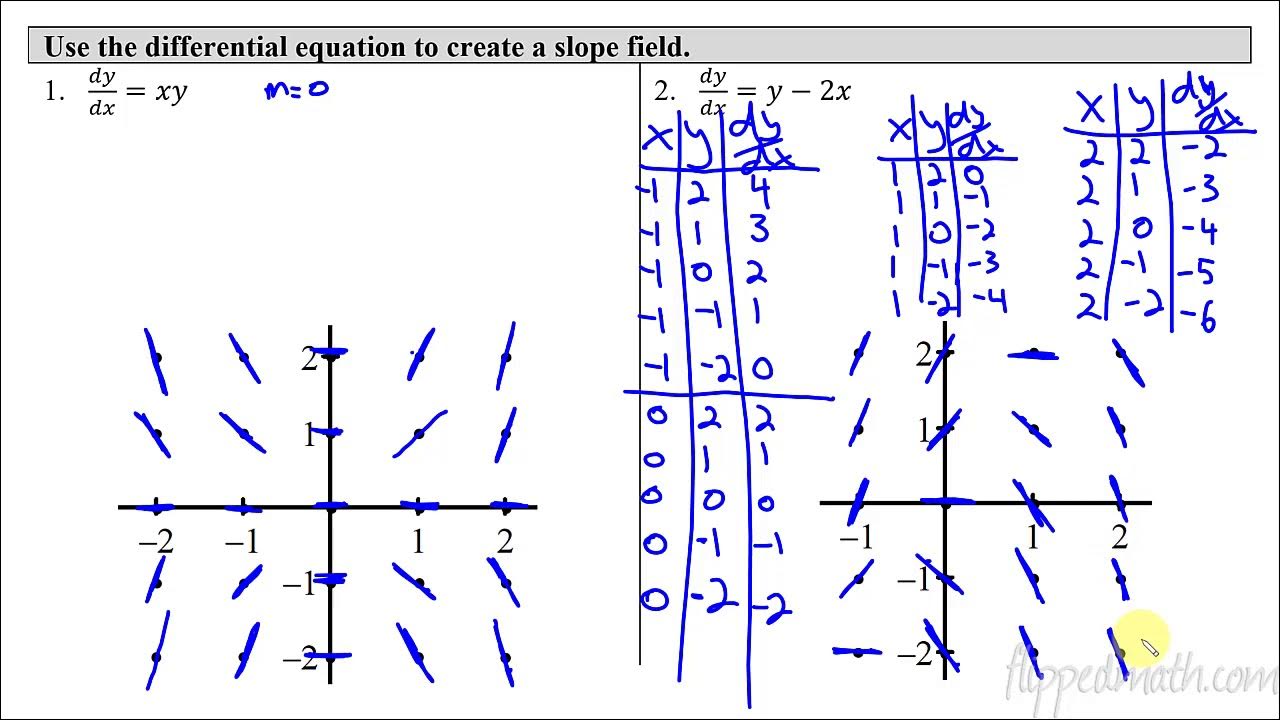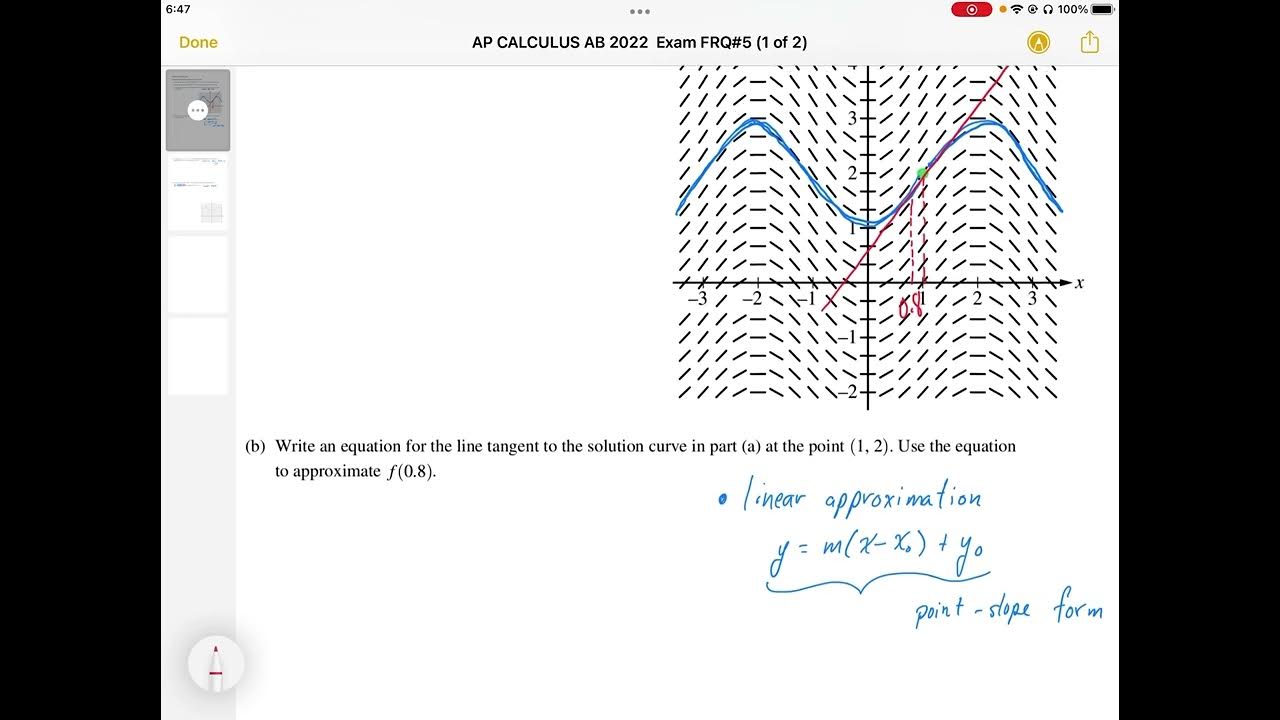Slope Fields
TLDRThis educational video delves into the concept of slope fields, a graphical representation of differential equations, essential for solving them. The instructor explains how to sketch slope fields and solution curves, using 'dy/dx = 2x' and 'dy/dx = y' as examples. They highlight the importance of recognizing patterns and the general solution's form, such as 'y = x^2 + c' for the former. The video also guides viewers in identifying the differential equation from a given slope field and emphasizes the techniques for tackling multiple-choice questions in AP Calculus, focusing on eliminating incorrect answer choices based on the dependence of 'dy/dx' on 'x' and 'y'.
Takeaways
- 📚 The video introduces the concept of slope fields, which are graphical representations of differential equations.
- 🔍 A slope field is created by plotting the rate of change (dy/dx) against the independent variable (x) and dependent variable (y).
- 📈 The video demonstrates how to sketch a slope field for a given differential equation, emphasizing that the slope depends only on 'x' in the first example.
- 📝 The process of sketching involves drawing horizontal tick marks to represent the slope at different points on the graph.
- 🧩 The video identifies 'y = x^2' as a particular solution to the differential equation dy/dx = 2x, highlighting that any vertical shift of this parabola would still satisfy the equation.
- 🔑 The general solution to dy/dx = 2x is given as y = x^2 + c, where 'c' is any constant, illustrating the concept of a family of solutions.
- 🎯 The second example involves a differential equation where dy/dx depends only on 'y', leading to the identification of y = e^x as a solution.
- 🔍 The video shows how to analyze a slope field to determine whether the differential equation depends on 'x', 'y', or both.
- 📉 For AP Calculus, students are expected to sketch slope fields and solution curves, but not derive equations from slope fields without given information.
- 📝 When sketching solution curves, the emphasis is on following the general pattern of the slope field rather than trying to match each tick mark exactly.
- 📈 The video concludes with a multiple-choice task to determine the differential equation from a given slope field, using elimination based on the observed dependencies and slopes.
Q & A
What is the main topic of the video?
-The main topic of the video is slope fields and solving differential equations.
What is a differential equation?
-A differential equation relates a function, its independent variable (usually x), and its rate of change (dy/dx).
What is a slope field?
-A slope field is a graph that represents the differential equation, showing the slope of the function at various points.
Why does the instructor suggest focusing only on x when sketching a slope field?
-The instructor suggests focusing only on x because dy/dx depends only on x, not on y, simplifying the process.
What is the differential equation represented by the first slope field in the video?
-The differential equation for the first slope field is dy/dx = 2x.
What is a particular solution to the differential equation dy/dx = 2x?
-A particular solution to the differential equation dy/dx = 2x is y = x^2.
What is the general solution to the differential equation dy/dx = 2x?
-The general solution to the differential equation dy/dx = 2x is y = x^2 + c, where c is any constant.
What is the differential equation represented by the second slope field in the video?
-The differential equation for the second slope field is dy/dx = y.
What is the general solution to the differential equation dy/dx = y?
-The general solution to the differential equation dy/dx = y is y = ce^x, where c is any constant.
What are the three things that students need to be able to do with slope fields in AP Calculus?
-In AP Calculus, students need to be able to sketch slope fields, sketch solution curves, and understand how to fit solution curves to a given slope field.
How does the instructor suggest sketching solution curves in slope fields?
-The instructor suggests sketching solution curves by following the general pattern of the slope field, using a pencil, and not trying to jump from tick mark to tick mark.
What is the differential equation for the slope field where dy/dx is independent of x?
-The differential equation for the slope field where dy/dx is independent of x is dy/dx = y + 1.
What is the differential equation for the slope field where dy/dx depends only on x?
-The differential equation for the slope field where dy/dx depends only on x is dy/dx = 1/x.
How can you determine if a slope field depends on x or y?
-You can determine if a slope field depends on x or y by observing if the slope changes when you manipulate x or y. If the slope changes with x, it depends on x; if it changes with y, it depends on y.
What is a common mistake when sketching solution curves in slope fields?
-A common mistake is trying to jump from tick mark to tick mark, which results in a robotic and non-curve-like appearance. Instead, one should follow the general pattern of the slope field.
What is the differential equation for the slope field that has zero slopes when x equals negative one?
-The differential equation for the slope field that has zero slopes when x equals negative one is dy/dx = -y + y.
Outlines
📈 Introduction to Slope Fields
This video introduces slope fields as part of a unit on solving differential equations. It explains the concept of a differential equation, which relates a function, its independent variable, and its rate of change. The video begins by emphasizing that for the given differential equation, dy/dx depends only on x. The process of sketching slope fields by creating a three-column chart and plotting points is demonstrated. The importance of understanding the behavior of the function at different points is highlighted, with an example showing how to draw slope marks for x values and their corresponding dy/dx.
🧮 Sketching a Slope Field for dy/dx = y
This section continues with an exercise to sketch a slope field for the differential equation dy/dx = y. It explains that dy/dx depends only on y, and describes how to fill in the slope field accordingly. The pattern in this slope field is identified as exponential, specifically y = e^x, with y = 0 and y = -e^x as other potential solution curves. The general solution is given as y = Ce^x, where C is any constant, and further explanation is provided on how these solutions fit the slope field.
📝 Sketching Solution Curves and AP Calculus Requirements
This paragraph discusses the requirements for AP Calculus concerning slope fields, emphasizing the need to sketch slope fields and solution curves. It explains the method of sketching solution curves by following the general pattern of the slope field. The importance of extending the solution curve to the edges of the field and avoiding contradictions with the slope field is highlighted. Examples are provided to demonstrate how to sketch solution curves for different differential equations and how to identify patterns.
🔍 Identifying Differential Equations from Slope Fields
The focus here is on identifying differential equations from given slope fields. It outlines techniques to determine if dy/dx depends on x or y by observing the changes in slopes when moving left-right or up-down. Examples are provided to illustrate this method, showing how to derive potential differential equations based on the observed slope patterns. The importance of recognizing dependencies on x or y and how this can help eliminate incorrect answer choices in multiple-choice settings is discussed.
✅ Matching Slope Fields to Differential Equations
This final section covers a multiple-choice task of matching a given slope field to its corresponding differential equation. Strategies for elimination based on the dependence of dy/dx on x and y are emphasized. Specific examples are analyzed to demonstrate the process of identifying the correct differential equation. The goal is to understand how to use slope patterns to make educated guesses and eliminate incorrect options, with practical advice on how to approach such questions on assessments.
Mindmap
Keywords
💡Slope Fields
💡Differential Equation
💡dy/dx
💡Solution Curve
💡Particular Solution
💡General Solution
💡Exponential Growth
💡Zero Slope
💡Asymptote
💡Independent Variable
Highlights
Introduction to slope fields and solving differential equations.
Differential equations relate a function, its independent variable, and its rate of change (dy/dx).
A slope field is a graph of a differential equation, showing the behavior of the function's slope at various points.
dy/dx depends only on x, so we can simplify calculations by ignoring y in certain cases.
Explanation of how to sketch slope fields using horizontal tick marks for slope at given points.
Demonstrating the slope field for dy/dx = 2x and how the slopes change at different x values.
Identifying patterns in slope fields to find a family of solution curves, like y = x^2.
General solutions to differential equations can include a constant (e.g., y = x^2 + C).
Task to sketch a slope field for dy/dx = y and identify its pattern.
Recognizing exponential patterns in slope fields, such as y = e^x for dy/dx = y.
Explanation of trivial solutions like y = 0 and their relevance to differential equations.
Overview of AP Calculus requirements for slope fields: sketching fields, sketching solution curves, and understanding general solutions.
Determining if dy/dx depends only on x or y by observing changes in slopes across columns or rows.
Example problem to match differential equations to slope fields by eliminating choices based on dependencies on x and y.
Final tips for sketching solution curves accurately and recognizing patterns in slope fields.
Transcripts
Browse More Related Video

Calculus AB/BC – 7.3 Sketching Slope Fields

Differential equation from slope field | First order differential equations | Khan Academy

AP CALCULUS AB 2022 Exam Full Solution FRQ#5(a,b)

2005 AP Calculus AB Free Response #6

2015 AP Calculus AB Free Response #4

Creating a slope field | First order differential equations | Khan Academy
5.0 / 5 (0 votes)
Thanks for rating: